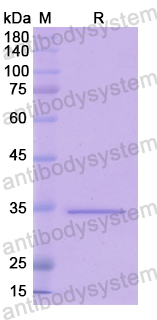Catalog No.
YHA20601
Expression system
E. coli
Species
Homo sapiens (Human)
Protein length
Ala31-Pro350
Predicted molecular weight
60.90 kDa
Nature
Recombinant
Endotoxin level
Please contact with the lab for this information.
Purity
>90% as determined by SDS-PAGE.
Accession
O14514
Applications
ELISA, Immunogen, SDS-PAGE, WB, Bioactivity testing in progress
Form
Lyophilized
Storage buffer
Lyophilized from a solution in PBS pH 7.4, 0.02% NLS, 1mM EDTA, 4% Trehalose, 1% Mannitol.
Reconstitution
Reconstitute in sterile water for a stock solution. A copy of datasheet will be provided with the products, please refer to it for details.
Shipping
In general, proteins are provided as lyophilized powder/frozen liquid. They are shipped out with dry ice/blue ice unless customers require otherwise.
Stability and Storage
Use a manual defrost freezer and avoid repeated freeze thaw cycles. Store at 2 to 8°C for frequent use. Store at -20 to -80°C for twelve months from the date of receipt.
Alternative Names
BAI1, Adhesion G protein-coupled receptor B1, Vstat120, ADGRB1, Vstat40, Brain-specific angiogenesis inhibitor 1
Regulation of hippocampal excitatory synapse development by the adhesion G-protein coupled receptor brain-specific angiogenesis inhibitor 2 (BAI2/ADGRB2)., PMID:40451404
Regulation of hippocampal excitatory synapse development by the adhesion G-protein coupled receptor Brain-specific angiogenesis inhibitor 2 (BAI2/ADGRB2)., PMID:39975290
CircUGP2 Suppresses Intrahepatic Cholangiocarcinoma Progression via p53 Signaling Through Interacting With PURB to Regulate ADGRB1 Transcription and Sponging miR-3191-5p., PMID:39120980
Novel Isoforms of Adhesion G Protein-Coupled Receptor B1 (ADGRB1/BAI1) Generated from an Alternative Promoter in Intron 17., PMID:38941066
A functional schizophrenia-associated genetic variant near the TSNARE1 and ADGRB1 genes., PMID:38702885
A Functional Schizophrenia-associated genetic variant near the TSNARE1 and ADGRB1 genes., PMID:38187620
Single-step genome-wide association analyses for selected infrared-predicted cheese-making traits in Walloon Holstein cows., PMID:37567464
Estimation of genetic parameters and single-step genome-wide association studies for milk urea nitrogen in Holstein cattle., PMID:36460511
Phosphatidylserine exposure modulates adhesion GPCR BAI1 (ADGRB1) signaling activity., PMID:36370845
Single Nucleus Transcriptome Data from Alzheimer's Disease Mouse Models Yield New Insight into Pathophysiology., PMID:36213995
Determinants of affinity, specificity, and phase separation in a supramodule from Post-synaptic density protein 95., PMID:36157580
Maternal exposure to atmospheric PM2.5 and fetal brain development: Associations with BAI1 methylation and thyroid hormones., PMID:35738517
Large-scale discovery of novel neurodevelopmental disorder-related genes through a unified analysis of single-nucleotide and copy number variants., PMID:35468861
A correlation study of adhesion G protein-coupled receptors as potential therapeutic targets in Uterine Corpus Endometrial cancer., PMID:35413679
Mice lacking full length Adgrb1 (Bai1) exhibit social deficits, increased seizure susceptibility, and altered brain development., PMID:35114205
BAI1 as a Prognostic Marker of Clear Cell Renal Cell Carcinoma (ccRCC)., PMID:34475070
Therapeutic Application of Brain-Specific Angiogenesis Inhibitor 1 for Cancer Therapy., PMID:34298774
BAI1 nuclear expression reflects the survival of nonsmoking non-small cell lung cancer patients., PMID:33934543
LncRNA embryonic stem cells expressed 1 (Lncenc1) is identified as a novel regulator in neuropathic pain by interacting with EZH2 and downregulating the expression of Bai1 in mouse microglia., PMID:33340495
Brain-specific angiogenesis inhibitor 1 is expressed in the Myo/Nog cell lineage., PMID:32614850
Cardiotoxicity of cancer therapy and current research efforts., PMID:32496853
BAI1 acts as a tumor suppressor in lung cancer A549 cells by inducing metabolic reprogramming via the SCD1/HMGCR module., PMID:32255478
Molecular chaperone HspB2 inhibited pancreatic cancer cell proliferation via activating p53 downstream gene RPRM, BAI1, and TSAP6., PMID:31692031
EZH2 targeting reduces medulloblastoma growth through epigenetic reactivation of the BAI1/p53 tumor suppressor pathway., PMID:31582835
Phosphatidylserine on viable sperm and phagocytic machinery in oocytes regulate mammalian fertilization., PMID:31575859
The adhesion-GPCR BAI1 shapes dendritic arbors via Bcr-mediated RhoA activation causing late growth arrest., PMID:31461398
Mapping Interactions of Microbial Metabolites with Human G-Protein-Coupled Receptors., PMID:31378678
Characterization of upregulated adhesion GPCRs in acute myeloid leukemia., PMID:31153896
Macrophages Do Not Express the Phagocytic Receptor BAI1/ADGRB1., PMID:31130954
Structure of BAI1/ELMO2 complex reveals an action mechanism of adhesion GPCRs via ELMO family scaffolds., PMID:30604775
Pooled extracellular receptor-ligand interaction screening using CRISPR activation., PMID:30477585
New Targets for Parkinson's Disease: Adhesion G Protein-Coupled Receptor B1 is Downregulated by AMP-Activated Protein Kinase Activation., PMID:30004846
BAI1 Suppresses Medulloblastoma Formation by Protecting p53 from Mdm2-Mediated Degradation., PMID:29894688
Context-dependent compensation among phosphatidylserine-recognition receptors., PMID:29116131
Genetic Features of Aflatoxin-Associated Hepatocellular Carcinoma., PMID:28363643
Regulatory roles of brain-specific angiogenesis inhibitor 1(BAI1) protein in inflammation, tumorigenesis and phagocytosis: A brief review., PMID:28259299
BAI1 Orchestrates Macrophage Inflammatory Response to HSV Infection-Implications for Oncolytic Viral Therapy., PMID:27852701
Adhesion GPCRs as Modulators of Immune Cell Function., PMID:27832495
Biological effects of eukaryotic recombinant plasmid pReceiver-M61-BAI-1 transfection on T24 cells and HUVECs., PMID:27356780
Adhesion GPCRs in immunology., PMID:27131861
Boosting Apoptotic Cell Clearance by Colonic Epithelial Cells Attenuates Inflammation In Vivo., PMID:27037190
BAI1: from cancer to neurological disease., PMID:27008705
Emerging Roles of BAI Adhesion-GPCRs in Synapse Development and Plasticity., PMID:26881134
The adhesion GPCR BAI1 mediates macrophage ROS production and microbicidal activity against Gram-negative bacteria., PMID:26838550
Stalk-dependent and Stalk-independent Signaling by the Adhesion G Protein-coupled Receptors GPR56 (ADGRG1) and BAI1 (ADGRB1)., PMID:26710850
Apoptotic cell recognition receptors and scavenger receptors., PMID:26683144
The anti-inflammatory effects of platelet-derived microparticles in human plasmacytoid dendritic cells involve liver X receptor activation., PMID:26635040
Expression of brain‑specific angiogenesis inhibitor‑1 and association with p53, microvessel density and vascular endothelial growth factor in the tissue of human bladder transitional cell carcinoma., PMID:26129954
Apoptotic cells trigger a membrane-initiated pathway to increase ABCA1., PMID:26075824
BAI1 regulates spatial learning and synaptic plasticity in the hippocampus., PMID:25751059


